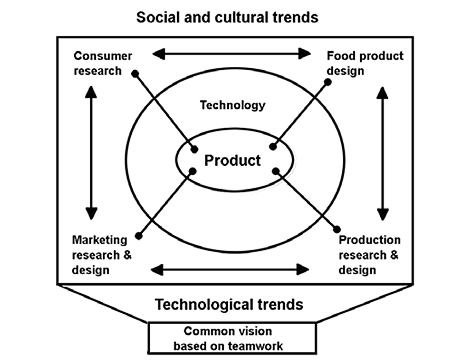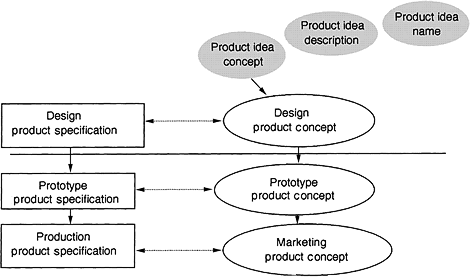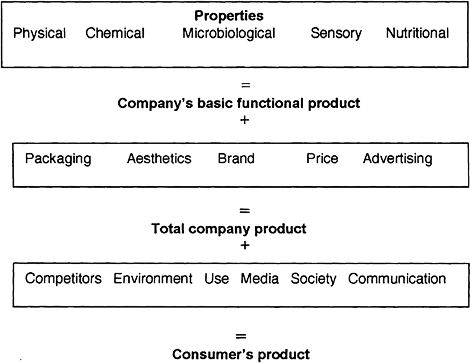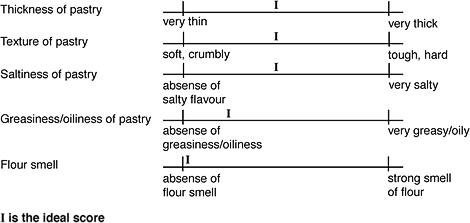FOOD
PRODUCT DEVELOPMENT
Mary Earle, Richard Earle and Allan Anderson |
| Loading
|
|
||||
|
|
Part
2, Chapter 3
The product development process 3.1.2 Developing the product concept The food industry has seldom used the word design
except as related to packaging and to advertising. The development of
the product has usually been called ‘product development’ and
had connotations of laboratory formulation and sensory panel. But today, there may be real benefits in adopting food product design and in associating food product design with other areas of design.
The product is an amalgam expected by the consumer of the hard values or the basic qualities and the soft values or the differentiating qualities such as aesthetic appearance and environmental friendliness. Product design, or the product creation process, is therefore an amalgamation of the disciplines of consumer and market research, technology and engineering research with design practice as shown in Fig. 3.3.  Fig. 3.3 Integrating the main disciplines in product creation (Source: After Blaich and Blaich, 1993). Product design is an essential part of the product creation process in equal cooperation with engineers, marketers and consumer researchers (Blaich and Blaich, 1993). All come together in the technology of the product.  Consumer researchers build the consumer/product relationship Consumer researchers build the consumer/product relationship throughout the PD Process.  The market researchers analyse markets and design the marketing The market researchers analyse markets and design the marketing and distribution methods in the market strategy.  The food engineer and technologist research the product and the The food engineer and technologist research the product and the process together in co-engineering and design the production and physical distribution methods.  The food product designer researches the social and cultural The food product designer researches the social and cultural backgrounds and designs the holistic product. It is important that these are all integrated from the beginning of the PD Process. As the product concept and the product design specifications are built up, all aspects are brought together; then as the project progresses, the people involved understand what is needed in the design of product, production and marketing to satisfy the consumers' needs, wants and behaviour. The product design process is subject to a set of requirements (product design specification), including basic and desirable product functions, performance, aesthetics and cost (Dasgupta, 1996). This is common to many industrial areas but is now only becoming accepted in the food industry. Firstly, the consumers and product designers, very often with marketers, come together to develop a product concept, and then the technologists and engineers are brought in to develop the product design specification. Some of you may be thinking that this is sounding rather complicated, but actually you do it all the time but may be doing it without clear directions. Designers and the consumers have difficulty in working in the abstract and there is some design taking place either in drawings, computer descriptions or 'mock-up' products. Creativity starts here. It is a useless exercise for marketing to work alone with consumers to develop a product concept and then hand it to the food designer/technologist and say make this! That seldom leads to unique products. There needs to be cooperation among marketing, consumer and the product designers (or food technologists / product developers as they are often called in the food industry). The areas in building the product concept for design are (Ulrich and Eppinger, 1995):  identifying consumer needs; identifying consumer needs;
 establishing target product brief; establishing target product brief;
 analysis of competitive products; analysis of competitive products;
 concept generation; concept generation;
 concept selection. concept selection.
The project team works between these areas. Firstly they study consumers, trying to build their needs into more specific terms in the product brief, and at the same time studying the competing products. Then they go back to the consumers with more defined product types to generate specific product concepts. Finally they work the product concepts into more specific and detailed product descriptions and go back to the consumers to find their reactions. The product concept progresses through the product development project from the original idea to the final product specifications controlling production and the final product proposition that is the basis for the marketing. It is refined and expanded in two different ways because of the different end uses - in a technical, quantitative description and in a consumer-based, in-depth, descrip- tion as shown in Fig. 3.4.  Fig. 3.4 Product concepts and product specifications in the product development project. The outcomes needed in the first stage are the design product concept and the design product specifications. These start from a name or a simple description in the product development programme, and firstly the team generates ideas for the product and then with consumers builds simple product idea concepts. After evaluation these are reduced to one or two product ideas, and research with consumers and the market gradually builds up the product concept for design. This is then integrated with the processing and marketing technologies, and the product concept is built up by product concept engineering into metric descriptions in the product design specification. The design product concept is the consumer's description of the product and includes the product character- istics, benefits and position in the market as identified by the consumer. The design product specification is developed from the product concept with reference to the technical aspects of the product, processing and distribution. It is the precise definition of what the product has to do, it is metric and has a value (Ulrich and Eppinger, 1995). A product has several layers and these are being built up gradually during the product development. There is the company's basic functional product, the total company product (with packaging, aesthetics, brand, price and advertising) and the consumer's product (which relates it to the competitors, the environment, the media, the society, as well as its communication and use) as shown in Fig. 3.5.  Fig. 3.5 The total food product (Source: From Schaffner, Schroder and Earle, Food Marketing: An International Perspective, © 1998, by permission of the McGraw-Hill Companies). There is a continuing interaction between these three layers of the food product, and therefore between the four groups of people - consumers, product designer, technical and marketing - during the development of the product concept and the product design specifications. To research the products, there is a need to identify the following:  Product morphology, the breakdown of a product into the Product morphology, the breakdown of a product into the specific characteristics (or attributes) that identify it to consumers or/and business customers. Determined by analysis of the product family and the individual product (Schaffner et al, 1998).  Product characteristics (or attributes), the features identifying the product Product characteristics (or attributes), the features identifying the product
to the company, the market and the consumer. Identified by consumers and designers in the creation of the product concept.  Product benefits, the product characteristics
important to the consumer. Product benefits, the product characteristics
important to the consumer. Identified in the consumer/product designer discussion groups. The product benefits are in four main areas - basic product benefits, package benefits, use benefits and psychological benefits - and these need to be integrated into the final consumer preference.  Product profile, the group of product characteristics which is the Product profile, the group of product characteristics which is the unique identification of the product - it is the product's DNA or fingerprint. In developing a product strategy to introduce meat pies to Malaysia by a New Zealand company, the activity was to identify the product benefits required by Chinese and Malaysian consumers; three techniques were used - focus group, consumer survey, and multidimensional scaling (MDS) as shown in Table 3.2. Table 3.2 Product benefits for meat pies in Malaysia
* Chinese and Malay women in Malaysia. t Malaysian students in New Zealand. Source: After Lai, 1987. The consumers compared the pie, particularly in the MDS, against the sweet and savoury baked/fried snacks already eaten in Malaysia. The MDS identified the main characteristics, and the focus group and the consumer survey identified general product benefits. To design the products more information was needed, and a sensory ideal product profile was identified by a small group of the consumers tasting the preliminary experimental products. The consumers' sensory characteristics were 7 for the pie top, 5 for the pie bottom and 14 for the pie filling. The five scales for the pastry bottom with the consumers' ideal scores are shown in Fig. 3.6.  Fig. 3.6 A product profile for pastry (Source: After Lai, 1997). The scales with their ideal points were included in the product design specification. The product profile needed to be analysed in two ways - what do the consumers mean by an ideal score of 5 for the pastry thickness? Can a physical measurement mimic this sensory characteristic? It is easy for thickness. Texture can also be measured in a physical instrument, but it may be necessary to train a panel to judge 'flour smell' and 'oiliness' unless a chemical test can be found for them. The important product benefits may include the type of raw materials and processing, as in organic foods and environmentally friendly foods, as well as the recognised consumer concerns of nutrition, safety, eating qualities and the psychological benefits such as prestige and fun (Earle and Earle, 2000). There has been a concentration on sensory benefits as shown by the rapid development of sensory science but this needs to be made much wider to include all benefits. An example of a product concept strongly based on the psychological needs is described in Box 3.1, a product concept for pet foods.
The concept of the package often follows the more traditional path of industrial design, developing a product architecture that defines the major subsystems of the package such as the inner, outer, closure, seals. Product architecture can also be useful in building up products such as complete meals with various meat, vegetables and noodles in some type of display pack.
|
|
 |